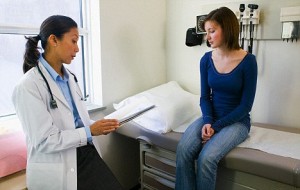 Researchers have found that half of all urban teenage girls will acquire at least one sexually transmitted infection (STI) within two years of becoming sexually active. It also found that 92 percent of these teens were re-infected within four years of their first infection.
Researchers have found that half of all urban teenage girls will acquire at least one sexually transmitted infection (STI) within two years of becoming sexually active. It also found that 92 percent of these teens were re-infected within four years of their first infection.
According to an Indiana University (IU) School of Medicine and Regenstrief Institute study, researchers followed 381 girls between the ages of 14 and 17 and found that half of the girls contracted chlamydia, gonorrhea and trichomoniasis within one year of becoming sexually active. They also found that re-infection rates were also high.
“Depending on the organism, within four to six months after treatment of the previous infection, a quarter of the women were re-infected with the same organism,” said Wanzhu Tu, Ph.D., associate professor of medicine at the IU School of Medicine and a Regenstrief Institute investigator.
Within two years, about three-quarters of participants with an initial sexually transmitted STI were diagnosed with a second STI, although not necessarily of the same type. Within four years of an initial STI, virtually all (92 percent) of the participants had a subsequent STI.
“To our knowledge, this study provides the first data on the timing of the initial STI and subsequent STI following the onset of sexual activity in urban adolescent women,” said Dr. Tu.
The study also found that screening for STIs may not be initiated until several years after sexual activity begins, especially for girls who become sexually active at younger ages.
“This is important because many clinicians are reluctant to address sexual activity with younger teens, and may miss important prevention opportunities,” said J. Dennis Fortenberry M.D. M.S., professor of pediatrics at the IU School of Medicine, and senior author of the study.
As a result of their findings, the researchers call for STI screening in sexually active teenage girls within a year after first intercourse and for retesting of infected girls every 3 to 4 months.
Continuing surveillance may be necessary, they conclude, because of the continuing high risk of infection even if the first re-screening test result is negative.
The study, which was published in the December 2009 issue of Archives of Pediatrics and Adolescent Medicine, focused on lower income urban adolescents; a group characterized by early onset of sexual activity, multiple sexual partners, and high STI rates.
This entry was posted
on Tuesday, January 26th, 2010 at 3:18 pm and is filed under News & Commentary.
You can follow any responses to this entry through the RSS 2.0 feed.
Responses are currently closed, but you can trackback from your own site.
Study: Urban Teens At A High Risk For Multiple STIs
According to an Indiana University (IU) School of Medicine and Regenstrief Institute study, researchers followed 381 girls between the ages of 14 and 17 and found that half of the girls contracted chlamydia, gonorrhea and trichomoniasis within one year of becoming sexually active. They also found that re-infection rates were also high.
“Depending on the organism, within four to six months after treatment of the previous infection, a quarter of the women were re-infected with the same organism,” said Wanzhu Tu, Ph.D., associate professor of medicine at the IU School of Medicine and a Regenstrief Institute investigator.
Within two years, about three-quarters of participants with an initial sexually transmitted STI were diagnosed with a second STI, although not necessarily of the same type. Within four years of an initial STI, virtually all (92 percent) of the participants had a subsequent STI.
“To our knowledge, this study provides the first data on the timing of the initial STI and subsequent STI following the onset of sexual activity in urban adolescent women,” said Dr. Tu.
The study also found that screening for STIs may not be initiated until several years after sexual activity begins, especially for girls who become sexually active at younger ages.
“This is important because many clinicians are reluctant to address sexual activity with younger teens, and may miss important prevention opportunities,” said J. Dennis Fortenberry M.D. M.S., professor of pediatrics at the IU School of Medicine, and senior author of the study.
As a result of their findings, the researchers call for STI screening in sexually active teenage girls within a year after first intercourse and for retesting of infected girls every 3 to 4 months.
Continuing surveillance may be necessary, they conclude, because of the continuing high risk of infection even if the first re-screening test result is negative.
The study, which was published in the December 2009 issue of Archives of Pediatrics and Adolescent Medicine, focused on lower income urban adolescents; a group characterized by early onset of sexual activity, multiple sexual partners, and high STI rates.
This entry was posted on Tuesday, January 26th, 2010 at 3:18 pm and is filed under News & Commentary. You can follow any responses to this entry through the RSS 2.0 feed. Responses are currently closed, but you can trackback from your own site.